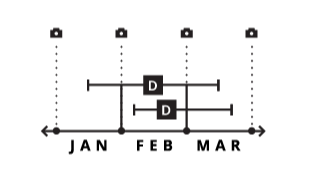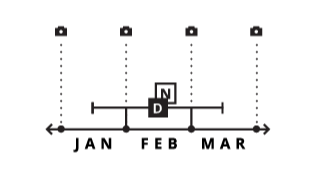When a user selects the option to create a new measure, he or she is prompted to select from a variety of commonly used templates to aid in the measure’s creation. Choosing the “blank” option allows the user to create the measure fully by hand. The list below provides a catalog of the templates available in Ursa Studio.
Event Measures
Appropriate for simple collections of records representing events that will be tracked over time. |  |
 | Event D Followed by Event NAppropriate for measures where the opportunity for performance can be represented as an initial event (Event D) and performance can be assessed based on the existence, timing, and/or characteristics of a single subsequent event (Event N). |
Event D Followed by Multiple Instances of Event NAppropriate for measures where the opportunity for performance can be represented as an initial event (Event D) and performance can be assessed based on the existence, timing, and/or characteristics of one or more subsequent events (Event N). |  |
 | Event D Preceded by Event NAppropriate for measures where the opportunity for performance can be represented as an initial event (Event D) and performance can be assessed based on the existence, timing, and/or characteristics of a single previous event (Event N). |
Event D Preceded by Multiple Instances of Event NAppropriate for measures where the opportunity for performance can be represented as an initial event (Event D) and performance can be assessed based on the existence, timing, and/or characteristics of one or more previous events (Event N). |  |
 | Singleton Event DAppropriate for measures where the opportunity for performance can be represented as an event (Event D) and performance can be assessed based on the properties of that same event. |
Count of Event NAppropriate for measures where the desired quantity is a count of events expressed as a rate per designated unit of elapsed time. |  |
Interval Measures
 | Interval D Containing Multiple Instances of Event NAppropriate for measures where the opportunity for performance can be represented as an interval (Interval D) and performance can be assessed based on the existence, timing, and/or characteristics of one or more events that fall within that interval (Event N). Common examples of this type of measure include per-member-per-month spending (PMPM), population rates of admissions or other encounter types. |
Entity Measures
Registry of EntitiesAppropriate for simple collections of records representing patients or other entities that will be tracked over time, as of one or more snapshot dates. |  |
 | Entity D with Single Past Instance of Event NAppropriate for measures where the opportunity for performance can be represented as a entity or timeline (Entity D) and performance can be assessed based on the existence, timing, and/or characteristics of a single previous event (Event N). |
Entity D with Multiple Past Instance of Event NAppropriate for measures where the opportunity for performance can be represented as a entity or timeline (Entity D) and performance can be assessed based on the existence, timing, and/or characteristics of one or more previous events (Event N). |  |
 | Singleton Entity DAppropriate for measures where the opportunity for performance can be represented as an entity (Entity D) and performance can be assessed based on the properties of that same entity. |
Count of Entity NAppropriate for measures where the desired quantity is a count of entities as of one or more snapshot dates. |  |
Static Measures
 | Registry of Static RecordsAppropriate for simple collections of records of any kind that do not need to be tracked over time. |
Count of Object N RecordsAppropriate for measures where the desired quantity is a count of instances of an object or single stack. |  |